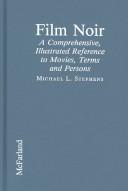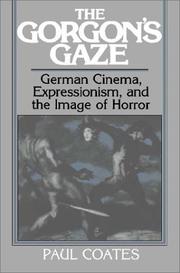| Listing 1 - 8 of 8 |
Sort by
|

ISBN: 0899508022 Year: 1995 Publisher: Jefferson McFarland
Abstract | Keywords | Export | Availability | Bookmark
 Loading...
Loading...Choose an application
- Reference Manager
- EndNote
- RefWorks (Direct export to RefWorks)
Film noir --- Films noirs --- Dictionaries --- Dictionnaires anglais --- -Cinéma noir --- Dark crime films --- Film noirs --- Noir films --- Crime films --- Encyclopedias --- Encyclopedias. --- -Encyclopedias --- Dictionaries. --- Cinéma noir
Book
ISBN: 3741000752 3894729473 Year: 2020 Publisher: Schüren Verlag
Abstract | Keywords | Export | Availability | Bookmark
 Loading...
Loading...Choose an application
- Reference Manager
- EndNote
- RefWorks (Direct export to RefWorks)
Long description: Im heutigen Zeitalter der Unsicherheit und Angst florieren konspirative Fantasien zuhauf. Verschwörungsfiktionen haben insbesondere in Film und Fernsehen Konjunktur. Im Zentrum des vorliegenden Bandes steht daher die Frage nach der medialen Konstruktion der kollektiven Imagination einer durch Verschwörung gesteuerten Welt. Dabei wird die These vertreten, dass die konspirationistische Fantasie als imaginäre Lösung und Reaktion auf die postmoderne Zersplitterung des Wissens zu begreifen ist, nachdem Jean-François Lyotard das Ende der “großen Erzählungen” der Moderne von Fortschritt und Emanzipation deklarierte. Gleichsam als Kompensation für diesen Sinnverlust bietet die konspirationistische Imagination neue, große Erzählungen an, nun freilich nicht mehr als optimistische Aufklärungsteleologie, sondern als dystopisches und mitunter apokalyptisches Narrativ. In der Inszenierung konspirativer und paranoider Szenarien kommt dabei dem Spielfilm eine privilegierte Rolle zu. Für die Gruppierung von Verschwörungsthrillern, paranoiden Dramen und mind-game-Filmen mit zunehmend vergrößerter konspirativer Reichweite hat sich in der Filmwissenschaft der ursprünglich aus der Fankultur stammende Begriff des Paranoiafilms durchgesetzt. Dieses zunehmend bedeutende mediale Phänomen wird hier erstmals umfassend in Theorie und Geschichte poetologisch und hermeneutisch gewürdigt. Im theoretischen Teil des Buches stehen genretheoretische, formale, narrative und motivische Aspekte des Paranoiafilms zur Diskussion, während dazu gleichzeitig die Themen Verschwörung, Paranoia und Verschwörungstheorie besprochen und in Beziehung gesetzt werden. Im historischen Teil werden in chronologischer Abfolge vier paradigmatische Narrative untersucht: der vorwiegend psychologisch ausgerichtete Meisterverbrecherfilm der 1910er bis 1930er Jahre; die paranoiden Spielarten des Film Noir in den 1940er und 50er Jahren, unter Einbezug des postklassischen Noir der 60er Jahre; der moderne, soziologische Verschwörungsfilm der 1960er bis 80er Jahre, in dem die Konspirationen zunehmend systemisch und unsichtbar werden; und schließlich die mind-game oder mindbender genannten Filme seit den 1990er Jahren, die sich im Zeichen der Metafiktion mit ontologischen und kosmologischen Verschwörungen beschäftigen. Zentrale Topoi sind unter anderem Mind Control, “Gehirnwäsche” und Überwachung. Nicht zuletzt geht es dabei auch um eine Allegorisierung der jeweils vorherrschenden Medien und ihrer Wirkungsmacht.
Verbrecher --- Fake News --- Film Noir --- Mind-Games --- Cinéma noir --- Dark crime films --- Film noirs --- Films noirs --- Noir films --- Crime films --- News, Fake --- Disinformation --- Hoaxes --- Journalism --- Nonbooks, PBS / Sachbücher/Musik, Film, Theater/Film --- Filmgenres
Book
ISBN: 0823287793 0823287661 Year: 2020 Publisher: New York : Fordham University Press,
Abstract | Keywords | Export | Availability | Bookmark
 Loading...
Loading...Choose an application
- Reference Manager
- EndNote
- RefWorks (Direct export to RefWorks)
Noir Affect proposes a new understanding of noir as defined by negative affect. This new understanding emphasizes that noir is, first and foremost, an affective disposition rather than a specific cycle of films or novels associated with a given time period or national tradition. Instead, the essays in Noir Affect trace noir’s negativity as it manifests in different national contexts from the United States to Mexico, France, and Japan and in a range of different media, including films, novels, video games, and manga. The forms of affect associated with noir are resolutely negative: These are narratives centered on loss, sadness, rage, shame, guilt, regret, anxiety, humiliation, resentment, resistance, and refusal. Moreover, noir often asks us to identify with those on the losing end of cultural narratives, especially the criminal, the lost, the compromised, the haunted, the unlucky, the cast-aside, and the erotically “perverse,” including those whose greatest erotic attachment is to death. Drawing on contemporary work in affect theory, while also re-orienting some of its core assumptions to address the resolutely negative affects narrated by noir, Noir Affect is invested in thinking through the material, bodily, social, and political–economic impact of the various forms noir affect takes. If much affect theory asks us to consider affect as a space of possibility and becoming, Noir Affect asks us to consider affect as also a site of repetition, dissolution, redundancy, unmaking, and decay. It also asks us to consider the way in which the affective dimensions of noir enable the staging of various forms of social antagonism, including those associated with racial, gendered, sexual, and economic inequality. Featuring an Afterword by the celebrated noir scholar Paula Rabinowitz and essays by an array of leading scholars, Noir Affect aims to fundamentally re-orient our understanding of noir.Contributors: Alexander Dunst, Sean Grattan, Peter Hitchcock, Justus Nieland, Andrew Pepper, Ignacio Sánchez Prado, Brian Rejack, Pamela Thoma, Kirin Wachter-Grene
Film noir. --- Cinéma noir --- Dark crime films --- Film noirs --- Films noirs --- Noir films --- Crime films --- Affect. --- Film Noir. --- Negativity. --- Neoliberalism. --- Noir. --- Popular Culture. --- Psychoanalysis. --- Pulp literature. --- Video Games.
Book
ISBN: 3030386589 3030386570 Year: 2020 Publisher: Cham : Springer International Publishing : Imprint: Palgrave Macmillan,
Abstract | Keywords | Export | Availability | Bookmark
 Loading...
Loading...Choose an application
- Reference Manager
- EndNote
- RefWorks (Direct export to RefWorks)
This book argues that adaptation is an underrecognized yet constitutive element of Nordic noir. In so doing, it reframes the prevailing critical view. Now celebrated for its global sweep, Nordic noir is equally a transmedial phenomenon. Nordic Noir, Adaptation, Appropriation deploys the tools of current adaptation studies to undertake a wide-ranging transcultural, intermedial exploration, adding an important new layer to the rich scholarship that has arisen around Nordic noir in recent years.
Film adaptations --- Noir fiction --- Film noir --- Motion pictures. --- Film genres. --- History and criticism. --- Genre films --- Genres, Film --- Motion picture genres --- Motion pictures --- Cinema --- Feature films --- Films --- Movies --- Moving-pictures --- Audio-visual materials --- Mass media --- Performing arts --- Cinéma noir --- Dark crime films --- Film noirs --- Films noirs --- Noir films --- Crime films --- Detective and mystery stories --- Fiction --- Plots, themes, etc. --- History and criticism --- Adaptation Studies. --- Genre.
Book
ISBN: 1474412688 147441267X 9781474412674 9781474412667 1474412661 9781474412681 Year: 2017 Publisher: Edinburgh : Edinburgh University Press Ltd,
Abstract | Keywords | Export | Availability | Bookmark
 Loading...
Loading...Choose an application
- Reference Manager
- EndNote
- RefWorks (Direct export to RefWorks)
The first comprehensive collection on the subject of Hong Kong neo-noir cinema, this book examines the way Hong Kong has developed its own unique and culturally specific version of the neo-noir genre, while at the same time drawing on and adapting existing international noir cinemas.
Film noir --- Cinéma noir --- Dark crime films --- Film noirs --- Films noirs --- Noir films --- Crime films --- History and criticism. --- China --- Chung-hua jen min kung ho kuo Hsiang-kang tʻe pieh hsing cheng chʻ --- Hong Kong --- Zhong hua ren min gong he guo Xiang gang te bie xing zheng qu --- Zhonghua Renmin Gongheguo Xianggang Tebie Xingzhengqu
Book
ISBN: 9780810859609 0810859602 9780810873780 0810873788 1282521918 9786612521911 9781282521919 6612521910 Year: 2010 Publisher: Lanham : Scarecrow Press,
Abstract | Keywords | Export | Availability | Bookmark
 Loading...
Loading...Choose an application
- Reference Manager
- EndNote
- RefWorks (Direct export to RefWorks)
The Historical Dictionary of Film Noir is a comprehensive guide that ranges from 1940 to present day neo-noir. It consists of a chronology, an introductory essay, a bibliography, a filmography, and over 400 cross-referenced dictionary entries on every aspect of film noir and neo-noir, including key films, personnel (actors, cinematographers, composers, directors, producers, set designers, and writers), themes, issues, influences, visual style, cycles of films (e.g. amnesiac noirs), the representation of the city and gender, other forms (comics/graphic novels, television, and videogames), and n
Film noir --- Motion picture producers and directors --- Motion picture actors and actresses --- Films noirs --- Producteurs et réalisateurs de cinéma --- Acteurs et actrices de cinéma --- Dictionaries --- Catalogs --- Dictionnaires anglais --- Catalogues --- Dictionnaires --- Crime films --- Producteurs et réalisateurs de cinéma --- Acteurs et actrices de cinéma --- Criminal films --- Cinéma noir --- Dark crime films --- Film noirs --- Noir films --- Motion pictures --- Caper films --- Thrillers (Motion pictures) --- Dictionaries. --- Catalogs.

ISBN: 0521384095 0521063361 1139085905 0511527128 Year: 1991 Publisher: Cambridge : Cambridge University Press,
Abstract | Keywords | Export | Availability | Bookmark
 Loading...
Loading...Choose an application
- Reference Manager
- EndNote
- RefWorks (Direct export to RefWorks)
The Gorgon's Gaze is an interdisciplinary study of recurrent themes in German cinema as it has developed since the early twentieth century. Focusing on pertinent films of the pre- and post-World War II eras, Paul Coates explores the nature of expressionism, which is generally agreed to have ended with the advent of sound cinema, and its persistence in the styles of such modern masters of Film noir as Orson Welles and Ingmar Bergman. In considering the possibility of homologies between the necessary silence of pre-sound cinema and the widespread modernist aspiration to an aesthetic of silence, Coates relates theories of the sublime, the uncanny, and the monstrous to his subject. He also reflects upon problems of representability and the morality of representation of events that took place during the Nazi era.
Film --- Germany --- Expressionism --- Monsters in motion pictures --- Motion pictures --- Expressionnisme --- Monstres dans le cinéma --- Cinéma --- History --- Histoire --- 791.43 --- Film noir --- -#SBIB:309H1320 --- Cinema --- Feature films --- Films --- Movies --- Moving-pictures --- Audio-visual materials --- Mass media --- Performing arts --- Cinéma noir --- Dark crime films --- Film noirs --- Films noirs --- Noir films --- Crime films --- Filmkunst. Films. Cinema --- De filmische boodschap: algemene werken (met inbegrip van algemeen filmhistorische werken en filmhistorische werken per land) --- History and criticism --- 791.43 Filmkunst. Films. Cinema --- Monstres dans le cinéma --- Cinéma --- #SBIB:309H1320 --- Aesthetics --- Expressionism. --- History. --- Monsters in motion pictures. --- History and criticism.
Book
ISBN: 3261044837 9783261044839 Year: 1992 Volume: 2 Publisher: Bern Peter Lang
Abstract | Keywords | Export | Availability | Bookmark
 Loading...
Loading...Choose an application
- Reference Manager
- EndNote
- RefWorks (Direct export to RefWorks)
Film --- United States --- Film adaptations --- Film noir --- Adaptations cinématographiques --- Films noirs --- History and criticism --- Histoire et critique --- 82:791.43 --- #SBIB:309H1326 --- #SBIB:033.GIFT --- film --- 791.41 --- misdaadliteratuur --- misdaadfilms --- film noir --- film en literatuur --- -Film adaptations. --- Adaptations, Film --- Books, Filmed --- Filmed books --- Films from books --- Literature --- Motion picture adaptations --- Motion pictures --- Cinéma noir --- Dark crime films --- Film noirs --- Noir films --- Crime films --- Literatuur en film --- Films met een amusementsfunctie en/of esthetische functie: genres en richtingen --- Adaptations --- Film adaptations. --- History and criticism. --- 82:791.43 Literatuur en film --- Adaptations cinématographiques --- -Film adaptations --- Verenigde Staten van Amerika --- Film noir - United States - History and criticism --- United States of America
| Listing 1 - 8 of 8 |
Sort by
|

 Search
Search Feedback
Feedback About
About Help
Help News
News